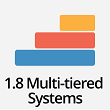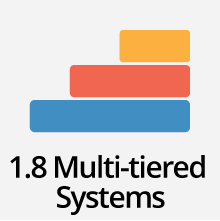
– How do I do this?
– What Barriers Might I Run Into and What Are Solutions??
– Where do I go for more resources?
– References
Early education programs and schools can better meet children’s emotional and behavioral needs by being proactive and systematic. To help you and your staff be more proactive and systematic, think about adopting a program- or school-wide multitiered system of support (MTSS). No matter what you decide, focus on putting in place the policies and practices that promote children’s positive social-emotional development and reduce challenging behaviors that are identified in the other recommendations of this guide. In elementary schools, studies have found that school-wide multitiered systems of support reduced discipline referrals and suspensions and helped fifth-graders do better in school. In early childhood settings, research has found that multitiered systems of support helped improve social skills and reduce challenging behaviors. Using a multitiered system of support in your program will help provide supports to prevent challenging behaviors. This might include changing the classroom environment (see Recommendation 2.2) and promoting positive social-emotional development (see Recommendation 2.3). It will help identify children who need stronger or more customized supports to address challenging behaviors through developmental screening (see Recommendation 1.3), functional behavior assessment, and behavior support plans (Recommendation 3.1).
A multitiered system of support (MTSS) is a comprehensive framework for organizing practices into different levels, or tiers, to provide the differentiated supports for all children to succeed in inclusive and natural environments. In an MTSS, the first tier (universal) includes those practices and core instruction that promote the positive social-emotional development of all children. The second tier (targeted/secondary) includes targeted practices that identify and address needs of children at risk for challenging behaviors. The third tier (intensive/tertiary) includes practices for providing individualized, more intensive interventions to children with persistent challenging behaviors. Additional key features of an MTSS include universal screening, progress monitoring, and data-informed decision-making. Examples of an MTSS include the Pyramid Model and Positive Behavioral Interventions and Supports (PBIS).
To help decide if you should use an MTSS and which one you would like to adopt for your program/school, access the following resources:
How do I do this?
Step 1. Choose a diverse team to provide input. When you talk about starting a multitiered system of supports (MTSS) or any new curricula, assemble a diverse team that represents your staff and families well. This team should include yourself, providers/teachers, and other relevant program/school partners. This type of decision-making structure makes it more likely that everyone involved will be committed to the ultimate decisions you make.
Step 2. Consider key questions with the team. With your diverse team, think about these key questions to guide your ultimate decision about whether to adopt an MTSS:
- Has the MTSS been adopted successfully by programs/schools like ours?
- What does it take to fully implement the MTSS?
- What are the costs—money and time—to fully implement the MTSS with fidelity?
If your program/school decides to implement a multitiered system of support framework, continue to step 3.
Step 3. Promote buy-in and commitment to implement the MTSS framework consistently. If you think it is right for your program, implement an MTSS framework that fits well with challenging behaviors you see at your school and the program/school context (see program-specific resource websites below). Once an MTSS framework has been chosen, the team should take the following steps to promote buy-in and fidelity of implementation:
- Have a formal kickoff.
- Put the program in place and schedule training.
- Decide what steps program/school leadership will take to support fidelity of implementation and sustainability.
- Acknowledge progress and excellent implementation.
Vignette 1: At the Blue Bonnet Early Childhood Development Center, when staff complete their Pyramid training, they are recognized at the weekly staff meeting and given a graduation certificate. Once trained, the staff each set goals for their Teaching Pyramid Model Observation Tool (TPOT) scores. When staff meet their goals, they are given a Lunch on Me! Certificate.
Vignette 2: At the Little River preschool program, administrators and other staff give out “gotchas” to acknowledge use of PBIS practices. The name of the staff member observed implementing a practice is written on a slip of paper and put into a shoe box. Every two weeks, the program holds a drawing and the chosen staff member gets to select one of the following rewards:
- Coverage to leave 30 minutes early one day
- Coverage for recess/outside play duty for one day
- Coverage for a 45-minute lunch off campus
- Privilege of using the Reserved Parking spot for two weeks
- Assess progress and new needs.
What Barriers Might I Run Into and What Are Solutions?
Potential Barrier: I’ve heard of multitiered systems of support, but it seems like adding an MTSS framework is a BIG deal and overwhelming.
Solution: An MTSS framework can actually help your program/school streamline and organize the practices, curricula, or interventions you already offer to be aligned at each level of the MTSS to children’s needs. This often this means you are NOT adding curricula as much as ensuring you have the proper level of support for each tier. If it is implemented thoughtfully, an MTSS framework can simplify and align processes.
Potential Barrier: I need resources for providing training and professional development on multitiered systems of support.
Solution: If you are part of or affiliated with a local or state public preschool program, your school or district might have already have implemented a tiered system of support. If so, you are most likely entitled to have your staff access or be provided trainings for little or no cost. The PBIS Center website and Pyramid Model website provide a variety of free resources, but the framework you select should have training and professional development materials and offerings available.
Potential Barrier: My program doesn’t have the resources or funding.
Solution: Your local Child Care Resource and Referral agency can help you find local free and low-cost training opportunities. They can also help you find grants for additional funding and resources. You can locate Child Care Resource and Referral agencies in your area through Child Care Aware’s search tool. Its State by State Resource Map can point you in the right direction for local resources on child care, health and social services, financial assistance, support for children with special needs, and more.
Potential Barrier: My staff are resistant to adopting new practices.
Solution: Engaging staff in exploration and decision-making processes promotes buy-in and makes it more likely that all interested parties—staff and families—will be committed to the ultimate decision. Communicate to staff that investment in the MTSS model reduces behavioral incidences and increases children’s engagement, learning time, and children’s acquisition of skills.
Potential Barrier: We’ve tried implementing evidence-based practices or curricula before, but it doesn’t last.
Solution: Support the ongoing implementation of practices. Evidence shows that providing a one-time training without follow-up implementation supports is not effective. It is also crucial to integrate practices into everyday activities and build them into the daily schedule, with support or mentoring from coaches or peer teachers invaluable for reflection and practice change.
Where do I go for more resources?
- For resources on the Pyramid Model but also excellent resources for planning for implementation of a program- or school-wide MTSS in general, go to the National Center for Pyramid Model Innovations website or the Pyramid Model Consortium website. Some specific resources you might find useful as you get started include:
- For resources and information about Positive Behavioral Intervention and Supports (PBIS), go to the PBIS OSEP Technical Assistance Center website.
- For a self-assessment that you can adapt to assess progress and new needs in implementing an MTSS approach, see the School-Wide Positive Behavior Supports Implementation Blueprint and Self-Assessment.
References
Bradshaw, C., Mitchell, M., & Leaf, P. (in press). Examining the effects of school-wide positive behavioral interventions and supports on student outcomes: Results from a randomized controlled effectiveness trial in elementary schools. Journal of Positive Behavior Interventions.
Hemmeter, M. L., Fox, L., & Hardy, J. K. (2016). Supporting the Implementation of Tiered Models of Behavior Support in Early Childhood Settings. In Handbook of Early Childhood Special Education (pp. 247-265). Springer International Publishing.
Gettinger, M. & Stoiber, K. C. (2006). Functional assessment, collaboration, and evidence-based treatment: Analysis of a team approach for addressing challenging behaviors in young children. Journal of School Psychology, 44(3), 231-252.
U.S. Department of Health and Human Services & U.S. Department of Education (2014). Policy statement on expulsion and suspension in early childhood settings.
Center on the Social and Emotional Foundations for Early Learning (CSEFEL). How to choose a social-emotional curriculum. How do I decide? Series of guidelines. Accessed from http://csefel.vanderbilt.edu/documents/dmg_choose_se_curriculum.pdf
Lane, K.L., Menzies, H.M., Kalberg, J.M., & Oakes, W.P. (2012). A comprehensive, integrated three-tier model to meet students’ academic, behavioral, and social needs In K.R. Harris, S. Graham, T. Urdan, A.G. Bus, S. Major, & H.L. Swanson (Eds) APA educational psychology handbook, Vol 3: Application to learning and teaching (pp. 551-581). Washington, DC: American Psychological Association.
Minic, M., Smith, B. J., and Strain, P. (2009). Administrator strategies that support high fidelity implementation of the Pyramid Model for promoting social-emotional competence & addressing challenging behavior. Issue Brief. Technical Assistance Center on Social Emotional Intervention (TACSEI). Retrieved from http://challengingbehavior.fmhi.usf.edu/do/resources/documents/brief_administrator.pdf
